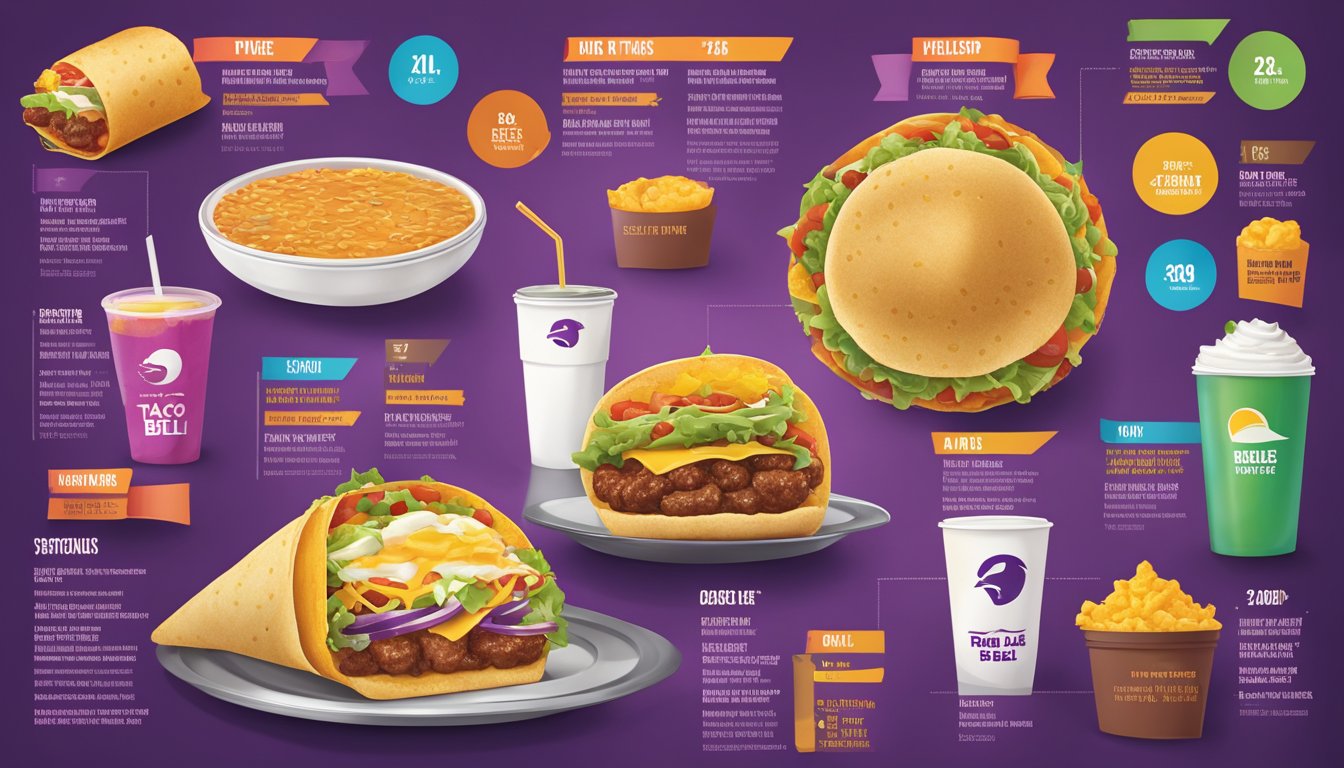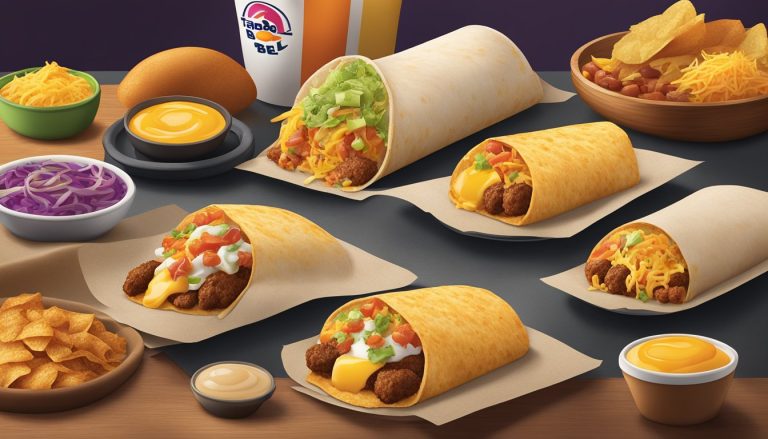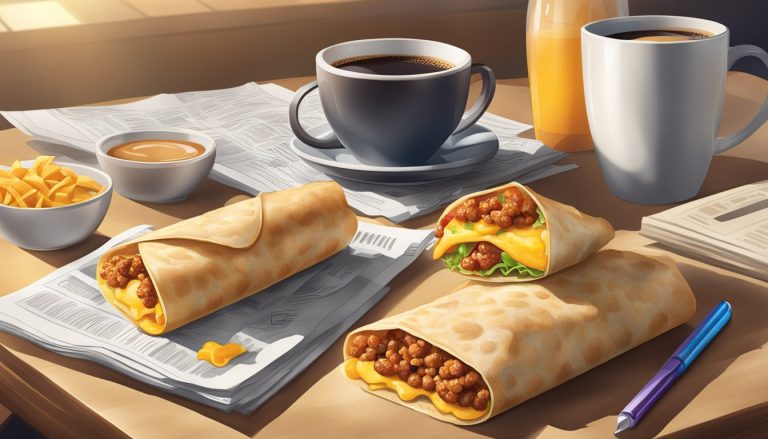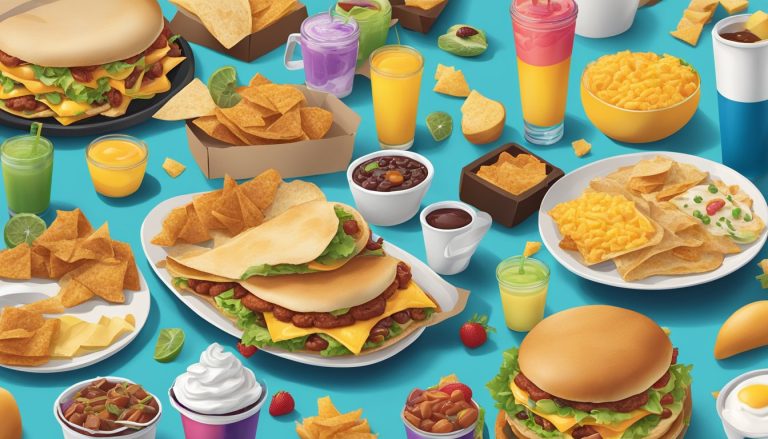Taco Bell, the popular fast-food chain known for its Mexican-inspired cuisine, has made significant strides in the breakfast market since entering it in 2014. While many are familiar with their lunch and dinner offerings, the company’s morning menu has its own fascinating history and unique features that set it apart from competitors.
Taco Bell’s breakfast menu represents a bold move into territory traditionally dominated by other fast-food giants. From innovative menu items to strategic marketing campaigns, the company has worked to carve out its own niche in the morning meal space. This article explores ten lesser-known facts about Taco Bell’s breakfast history, shedding light on how the chain has transformed the fast-food breakfast landscape.
1) Taco Bell started breakfast in 2014

Taco Bell made a significant move into the breakfast market in 2014. The fast-food chain launched its breakfast menu nationwide on March 27 of that year.
This expansion marked a new chapter for the company, which had previously focused primarily on lunch and dinner offerings. The breakfast rollout was accompanied by Taco Bell’s largest marketing campaign to date.
The decision to enter the breakfast scene came after observing the success of other fast-food establishments in this time slot. Taco Bell aimed to capitalize on the growing demand for quick and convenient morning meal options.
At the time of launch, then-CEO David Novak considered the breakfast menu one of the few initiatives that could truly change the company’s economic model. This strategic move positioned Taco Bell to compete directly with other fast-food giants in the lucrative breakfast market.
The introduction of breakfast items represented a significant shift in Taco Bell’s operations and menu offerings. It required adjustments to store hours and staff schedules to accommodate earlier opening times.
2) First breakfast menu included Waffle Taco
Taco Bell’s venture into the breakfast market in 2014 brought with it an innovative and eye-catching item: the Waffle Taco. This unique creation featured a folded waffle as its “shell,” filled with scrambled eggs, cheese, and a choice of bacon or sausage.
The Waffle Taco quickly became the face of Taco Bell’s breakfast launch, garnering significant media attention and consumer curiosity. Its unconventional design and blend of sweet and savory flavors aimed to set Taco Bell apart in the competitive fast-food breakfast arena.
Despite its initial fanfare, the Waffle Taco’s reign was short-lived. Within a year of its nationwide debut, Taco Bell removed it from the breakfast menu. The exact reasons for its discontinuation remain unclear, but it’s possible that the combination of syrupy waffle and savory fillings didn’t resonate with customers as expected.
Interestingly, while the Waffle Taco received much of the spotlight, it wasn’t actually the best-selling item on Taco Bell’s breakfast menu. That honor went to the A.M. Crunchwrap, which proved more popular among morning diners.
3) Breakfast hours end at 11 AM

Taco Bell’s breakfast service concludes promptly at 11 AM. This cutoff time applies to most locations across the country, giving early risers and morning commuters a four-hour window to enjoy their favorite breakfast items.
The 11 AM endpoint aligns with traditional fast food breakfast schedules. It allows Taco Bell to transition smoothly from breakfast to their regular menu offerings for lunch and dinner service.
Some Taco Bell locations may open later, particularly on weekends. In these cases, the breakfast window could be shorter, but the 11 AM end time typically remains consistent.
For those seeking breakfast items after 11 AM, options become limited. The kitchen switches over to prepare the standard menu, and breakfast-specific ingredients are typically put away until the next morning.
Customers are advised to plan accordingly if they wish to sample Taco Bell’s breakfast offerings. Arriving before 11 AM ensures access to the full range of morning menu items.
4) Cinnabon Delights were a hit item
Taco Bell’s collaboration with Cinnabon produced a breakfast sensation in 2013. Cinnabon Delights quickly became a popular menu item, appealing to customers with a sweet tooth.
These bite-sized treats consist of warm, dough balls coated in cinnamon sugar. Each pastry contains a creamy icing center, reminiscent of Cinnabon’s classic cinnamon rolls.
Taco Bell offers Cinnabon Delights in various pack sizes, including 2-packs, 4-packs, and 12-packs. This flexibility allows customers to choose portion sizes that suit their preferences.
The success of Cinnabon Delights contributed to Taco Bell’s expanding breakfast menu. These pastries joined other unique offerings like breakfast burritos and A.M. Crunchwraps.
Cinnabon Delights’ popularity stems from their satisfying taste and texture. The crispy exterior and gooey center provide a pleasant contrast, while the familiar Cinnabon flavor appeals to many customers.
5) Initially limited to only 10 US cities

Taco Bell’s breakfast menu didn’t launch nationwide immediately. The fast food chain took a cautious approach when introducing its morning offerings. In March 2014, Taco Bell rolled out breakfast items in just 10 select U.S. cities.
This limited release allowed the company to test customer reception and refine its breakfast operations. The initial cities served as pilot locations, helping Taco Bell gauge demand and gather feedback on their new menu items.
The chosen markets represented a diverse cross-section of the country. They included metropolitan areas with varying demographics and consumer preferences. This strategic approach enabled Taco Bell to fine-tune its breakfast offerings before a wider launch.
During this trial period, the company closely monitored sales data and customer responses. The information gathered from these 10 cities proved invaluable in shaping Taco Bell’s breakfast strategy moving forward.
After the successful limited release, Taco Bell expanded its breakfast menu nationwide later that same year. The phased rollout allowed the chain to build anticipation and ensure a smooth transition to serving breakfast across all locations.
6) Testing began in Southern California

Taco Bell’s breakfast journey started in Southern California, where the company first introduced its morning offerings. The fast food chain chose this region as a testing ground due to its established presence and loyal customer base.
In the early stages, Taco Bell experimented with various breakfast items to gauge customer interest. They carefully selected menu options that aligned with their Mexican-inspired cuisine while catering to American breakfast preferences.
The initial test locations provided valuable insights into consumer behavior and preferences. Taco Bell’s team closely monitored sales data and customer feedback to refine their breakfast menu.
This localized approach allowed the company to make necessary adjustments before expanding nationwide. By starting small in Southern California, Taco Bell could fine-tune its breakfast offerings and operational processes.
The success of these early tests in Southern California paved the way for Taco Bell’s eventual nationwide breakfast rollout. This strategic decision to begin testing in a familiar market proved crucial in shaping the company’s breakfast program.
7) A.M. Crunchwrap remains popular

The A.M. Crunchwrap has become a staple of Taco Bell’s breakfast menu since its introduction. This morning twist on the classic Crunchwrap Supreme continues to be a fan favorite.
Google Trends data from October 2020 to October 2021 revealed the Crunchwrap as Taco Bell’s most popular menu item nationwide. The breakfast version has contributed significantly to this popularity.
Many customers praise the A.M. Crunchwrap for its perfect combination of ingredients. The inclusion of a hash brown inside the wrap adds an extra layer of texture and flavor that resonates with breakfast enthusiasts.
The versatility of the A.M. Crunchwrap has also contributed to its enduring appeal. Customers can customize their order with different protein options, satisfying various taste preferences.
Taco Bell’s decision to keep the A.M. Crunchwrap on the menu reflects its consistent popularity. As breakfast habits evolve, this item remains a go-to choice for those seeking a portable and satisfying morning meal.
8) Menu inspired by traditional breakfast

Taco Bell’s breakfast menu draws inspiration from classic morning fare while adding a distinctive twist. The restaurant chain recognized the popularity of traditional breakfast items and incorporated them into their offerings.
Familiar ingredients like eggs, cheese, and bacon feature prominently in many of Taco Bell’s breakfast creations. These staples are reimagined in Mexican-inspired formats such as burritos and crunch wraps.
Hash browns, a breakfast favorite, also make an appearance on the menu. Taco Bell integrates this crispy potato side into various dishes, providing a satisfying crunch to their morning meals.
The menu combines recognizable breakfast elements with Taco Bell’s signature flavors and textures. This approach allows customers to enjoy familiar tastes in new and exciting forms.
By balancing tradition with innovation, Taco Bell crafted a breakfast menu that appeals to both conventional breakfast eaters and those seeking a unique morning dining experience. This strategy helped the chain establish itself in the competitive breakfast market.
9) Competes with McDonald’s breakfast
Taco Bell launched its breakfast menu nationwide in 2014, entering the competitive fast-food breakfast market. This move directly challenged McDonald’s long-standing dominance in the morning meal segment.
Taco Bell’s breakfast offerings feature unique items like breakfast burritos and Crunchwraps, differentiating itself from McDonald’s more traditional breakfast sandwiches. The Mexican-inspired chain aimed to attract younger customers with its bold flavors and creative menu options.
To promote its breakfast, Taco Bell employed aggressive marketing tactics. The company ran ads featuring real-life people named Ronald McDonald endorsing Taco Bell’s breakfast, playfully targeting its main competitor.
Taco Bell’s breakfast hours typically run from 7 to 11 a.m., slightly shorter than McDonald’s 6 to 11 a.m. window at 24-hour locations. This scheduling difference reflects each chain’s strategy for capturing the morning crowd.
While McDonald’s maintains a strong hold on the breakfast market, Taco Bell’s entrance has intensified competition. Both chains continue to innovate and adjust their breakfast menus to attract customers in this lucrative segment of the fast-food industry.
10) Innovative marketing campaigns used
Taco Bell has employed several creative marketing strategies to promote its breakfast menu. The “Think Outside the Bun” campaign was instrumental in transforming Taco Bell’s brand identity and positioning it as an innovative fast-food chain.
The company leveraged social media platforms effectively to reach younger audiences. On Snapchat, Taco Bell announced limited-time offers for menu items like the Beefy Crunch Burrito, capitalizing on the app’s ephemeral nature.
Taco Bell also used bold tactics to generate buzz. In 2001, they launched a space-themed campaign tied to the Mir space station, offering free tacos if certain conditions were met. This approach garnered significant attention and showcased the brand’s willingness to take risks.
Digital campaigns have played a crucial role in Taco Bell’s marketing strategy. The company has embraced emerging technologies and platforms to engage customers and create memorable experiences around its breakfast offerings.
These innovative campaigns have helped Taco Bell differentiate itself in the competitive fast-food breakfast market and build a strong connection with its target audience.
The Origins of Taco Bell’s Breakfast
Taco Bell’s venture into breakfast was a strategic move to capture the lucrative morning market. The company recognized the potential for growth and sought to differentiate itself from competitors with unique Mexican-inspired breakfast offerings.
Early Concept Development
Taco Bell began exploring breakfast options in the early 2000s. The chain’s culinary team experimented with various menu items, blending traditional American breakfast foods with Mexican flavors. They focused on creating portable, easy-to-eat options for on-the-go consumers.
Key early concepts included breakfast burritos and quesadillas filled with eggs, cheese, and meats. The team also developed innovative items like the Waffle Taco, which featured a folded waffle shell filled with breakfast staples.
Taco Bell’s goal was to offer something different from typical fast-food breakfast menus. This approach aimed to attract younger customers and those seeking alternatives to standard breakfast fare.
Initial Market Research
Before launching nationwide, Taco Bell conducted extensive market research to gauge consumer interest. The company tested breakfast items in select markets, gathering feedback on taste, pricing, and overall appeal.
Research showed that customers were intrigued by the idea of Mexican-inspired breakfast options. Taco Bell found that portability and customization were highly valued by potential breakfast patrons.
The company also studied competitors’ breakfast offerings to identify gaps in the market. This analysis helped Taco Bell refine its menu and marketing strategies.
Based on research findings, Taco Bell adjusted portion sizes, ingredient combinations, and pricing to better meet consumer expectations. This thorough approach laid the groundwork for the eventual national rollout of Taco Bell’s breakfast menu.
Expansion of Breakfast Offerings
Taco Bell’s breakfast menu evolved significantly since its initial launch, introducing innovative items and adapting to customer preferences. The expansion broadened appeal and solidified the chain’s position in the competitive morning food market.
Iconic Menu Items Introduced
Taco Bell’s breakfast innovation shone through with the Waffle Taco. This unique creation featured a folded waffle filled with eggs, cheese, and choice of bacon or sausage. The Breakfast Crunchwrap also made waves, combining scrambled eggs, hash browns, cheese, and meat in a grilled tortilla.
The A.M. Crunchwrap became a fan favorite, offering a portable twist on traditional breakfast sandwiches. Breakfast burritos and quesadillas joined the lineup, providing familiar options with a Taco Bell flair.
Cinnabon Delights, bite-sized pastries filled with cream cheese frosting, added a sweet touch to the menu. These indulgent treats quickly gained popularity among customers seeking a morning dessert.
Adaptation to Consumer Preferences
Taco Bell actively responded to changing consumer tastes. The chain introduced healthier options like the Mini Skillet Bowl, catering to calorie-conscious diners. Vegetarian choices expanded with the addition of items featuring potato and egg combinations.
Coffee offerings improved with the introduction of premium roasts and iced options. Taco Bell partnered with major coffee brands to enhance its beverage selection, meeting the demand for quality morning drinks.
Value-focused combos and $1 menu items addressed budget-conscious customers. This strategy aimed to compete with other fast-food chains’ breakfast deals, attracting price-sensitive consumers.
Regional menu variations emerged, tailoring offerings to local tastes. Some locations tested unique items like breakfast empanadas or chorizo options, gauging customer interest for potential nationwide rollouts.
Impact on the Fast Food Industry

Taco Bell’s entry into the breakfast market in 2014 sparked significant changes in the fast food landscape. This move challenged established players and influenced long-term industry trends.
Competitive Response
McDonald’s reacted swiftly to Taco Bell’s breakfast launch. The burger giant offered free coffee during breakfast hours to retain customers. Other chains like Burger King and Wendy’s also stepped up their breakfast game.
Taco Bell’s unique menu items, like the Waffle Taco and A.M. Crunchwrap, forced competitors to innovate. This led to a wave of new breakfast offerings across the industry. Many chains extended their breakfast hours to compete.
Some restaurants focused on improving coffee quality to match Taco Bell’s partnership with Cinnabon. The breakfast battle intensified marketing efforts, with companies increasing ad spending for morning meals.
Long-Term Trends Influenced
Taco Bell’s breakfast menu popularized the concept of “breakfast anytime.” This trend spread across the industry, with more chains offering all-day breakfast options.
The focus on portable breakfast items increased. Handheld options became more prevalent as other chains followed Taco Bell’s lead.
Taco Bell’s success encouraged more non-traditional breakfast players to enter the market. Mexican-inspired breakfast items gained traction at other restaurants.
The emphasis on value pricing for breakfast meals became more widespread. Chains started offering more combo deals and discount promotions during morning hours.
Breakfast menus became a key battleground for fast food innovation. Restaurants began introducing bolder flavors and unique ingredient combinations for morning fare.




